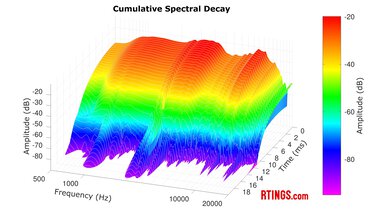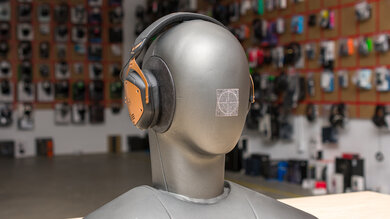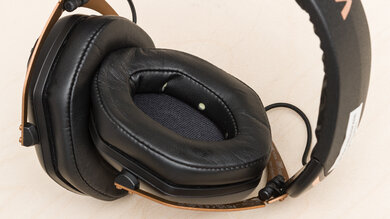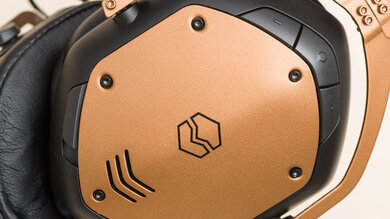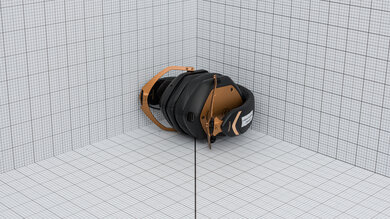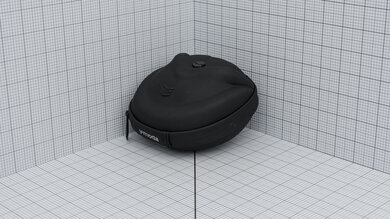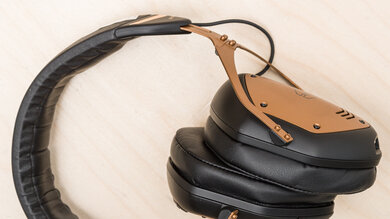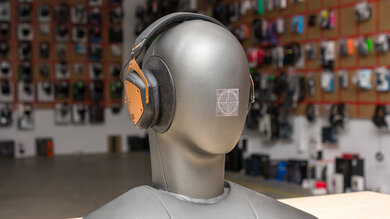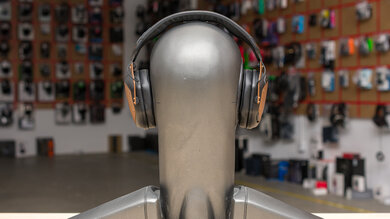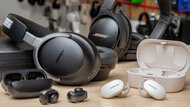The V-MODA Crossfade 3 are V-MODA's third entry in the Crossfade line. These visually striking headphones come with the V-MODA Crossfade headphones' signature hexagonal-shaped ear cups and updated features; this includes aptX HD compatibility, a longer battery life, and handy conveniences like a companion app and USB-C charging.
Our Verdict
The V-MODA Crossfade 3 are decent for sports and fitness use. Their stability is good enough for weight training in upright positions, but they will come loose if you try taking them on a run. The controls are easily accessible buttons, so even if your hands are sweaty, it's not too difficult to turn up the volume, for example. Meanwhile, their build quality feels robust. While they come in a case and can fold down to fit in a gym bag, they're still not very portable.
-
Robust build quality.
-
Somewhat bulky.
The V-MODA Crossfade 3 Wireless are mediocre for travel. Their lack of active noise cancelling puts a damper on commutes, as rumbling engines and airplane cabin noise don't get blocked out very well, though high-pitched sounds are somewhat reduced. In addition, they feel comfortable if you don't wear glasses and their battery life is more than enough for international flights. They collapse into a case for easy storage, but they're not the smallest headphones, even when folded down.
-
Robust build quality.
-
Comfortable unless you have glasses.
-
Poor overall noise isolation.
-
Somewhat bulky.
The V-MODA Crossfade 3 are an acceptable pick for office use. They feel comfortable if you don't wear glasses, although, for smaller and medium-sized heads, they can rest too much weight across the crown. The headphones' poor noise isolation means your coworkers' chatter will probably still bother you. Their battery life will last a few shifts without needing a recharge, so you won't get caught without music. While you can take calls fine with their integrated mic, background noise won't be well separated from your voice.
-
Robust build quality.
-
Comfortable unless you have glasses.
-
Overall microphone performance is middling.
-
Poor overall noise isolation.
The V-MODA Crossfade 3 aren't a great option for wireless gaming. While you can use their Bluetooth connectivity with a PC or phone, their latency will result in audio/visual desync.
The V-MODA Crossfade 3 are decent for wired gaming. Their analog connectivity with an in-line microphone means you can plug them into your PC and consoles. While their tuning doesn't sound especially analytical, the boom of explosions will feel immersive. However, the sound profile's scooped mids and dull treble means that dialogue can sound recessed and comparatively quiet. Your friends will hear you just fine, but the in-line mic rolls off the upper frequencies, so you won't sound true-to-life.
-
Comfortable unless you have glasses.
-
Overall microphone performance is middling.
The V-MODA Crossfade 3 have decent audio reproduction accuracy. Their warm sound signature is fairly smooth, though a mid-range dip slightly thins vocals and lead instruments, and a stepped peak in the low-treble—more prominent in the right driver—can make some acoustic elements like guitar strings sound painfully bright. Their L/R drivers are well-matched overall, but a stereo mismatch can subtly shift the stereo image. Glasses and thick hair also alter the headphones' ability to deliver consistent sound. Group delay is adequate, with minor fluctuations in the bass that are unlikely to impact the perceived clarity of low-frequency transients. They also perform remarkably well in harmonic distortion, delivering clean sound even at high levels. However, their PRTF measurements show poor pinna interaction, so they don't contribute much to immersive listening through outer ear cues.
The V-MODA Crossfade 3 have poor noise isolation performance. Without ANC, these headphones don't attenuate much noise in the bass and mids, letting through bus engines and most office chatter. That said, they don't leak too much audio, barely exceeding the noise floor of an average room in the mid-range.
The V-MODA Crossfade 3 have sub-par microphone performance. The ear cups' integrated mics reproduce your voice with a nasal tone missing a bit of low-end. The mics don't do a great job separating your voice from background voices and sustained noises. When wired, you can also use the in-line mic—though its recording quality is worse, and it doesn't handle noise any better.
The V-MODA Crossfade 3 have mediocre frequency response consistency. Since frequency response consistency determines how well headphones sound on different people and between wears, it's one key component in the experience that can account for perceptual differences between people with the same headphones. These demonstrate a fairly dramatic deviation if your hair is long or you wear glasses. With glasses that break the over-ear seal, bass is reduced. Meanwhile, people with long hair can perceive elevated bass and mids.
- 7.4 Sports And Fitness
- 6.3 Travel
- 6.0 Office Work
- 5.6 Wireless Gaming (In Development)
- 7.2 Wired Gaming (In Development)
Performance Usages
- 7.3 Audio Reproduction Accuracy
- 4.6 Noise Isolation
- 5.9 Microphone (In Development)
- 6.4 Frequency Response Consistency
Changelog
-
Updated Apr 25, 2025:
This review has been updated to Test Bench 2.0, which adds the following tests: Stereo Mismatch, Group Delay, Cumulative Spectral Decay, PRTF, Harmonic Distortion, and Electrical Aspects. We've added new performance usages and updated the text throughout the Sound tests and side-by-sides.
- Updated Apr 25, 2025: We've converted this review to Test Bench 2.0, which updates our sound tests and adds performance usages. You can read more about this in our changelog.
-
Updated Dec 19, 2024:
The following test groups have been updated following Test Bench 1.7: Noise Isolation - Full Range, Noise Isolation - Common Scenarios, and ANC Wind Handling. In addition, several Sound tests have been updated following Test Bench 1.8. There have also been text changes made throughout the review, including to the Usages and Product Comparisons to match these results.
- Updated Dec 09, 2024: We've converted this review to Test Bench 1.8, which updates our target curve and Sound tests. You can read more about this in our changelog.
- Updated Jul 30, 2024: We've converted this review to Test Bench 1.7, which updates our Noise Isolation test. We've also expanded the scope of this test to include Common Scenarios in addition to Voice Handling and Wind Handling.
Check Price
Differences Between Sizes And Variants
The V-MODA Crossfade 3 Wireless come in three colors, 'Matte Black,' 'Gunmetal Black,' and 'Bronze Black.' Through the manufacturer's website, you can customize the ear cups' plates with laser engravings and prints. You can view the label for our unit in 'Bronze Black' here. If you encounter another variant, please let us know in the comments.
Compared To Other Headphones
The V-MODA Crossfade headphones line has devoted followers with the previous version, the V-MODA Crossfade 2 Wireless, sporting compliance with Military-Level Quality MIL-STD-810G standard, which is determined through a series of stress tests like humidity and shock. Although the latest headphones don't have the MIL-STD-810G standard, they seem similarly durable. They both come with a one-year warranty and an 'Immortal Life Program,' but that simply means you get replacement parts at a discount. Improvements include a much better battery life on the V-MODA Crossfade 3, an upgraded Bluetooth codec selection, and a new companion app. If you own the old model and don't mind the battery life, you might not want to upgrade yet, but if you haven't got either, the new model is better.
Still, if you're in the market for wireless headphones for both casual use and DJing, you can always consider the Audio-Technica ATH-M50xBT2. These are the optionally wireless version of the Audio-Technica ATH-M50x, a model often found in DJ collections and in the hands of enthusiasts who like a bit of boom. They have a longer battery life than the V-Moda Crossfade 3 and a good amount of bass. That said, the Audio-Technica cans feel more plasticky, even if they have some metal to reinforce the headband.
For other great picks, check out the best wireless Bluetooth headphones. If you like the bass-heavy sound of these headphones but wonder what else is available, consider the best bass headphones. There are also the best DJ headphones if you're in charge of the music at the party.
The V-MODA Crossfade 3 are a bit better than the V-MODA Crossfade 2 Wireless, though they've more in common than not. The Crossfade 3 Wireless supply more than twice the battery life of the previous generation, and they charge with an updated USB-C port. Their app has an EQ to adjust their tuning and an upgraded aptX HD codec as an option. The Crossfade 2 Wireless use the good, but more basic, aptX codec. These also have a MIL-STD-810G certification; the manufacturer doesn't disclose whether the newer model has it. Both feel durable, with replacement parts available.
The V-MODA Crossfade 3 and the AIAIAI TMA-2 DJ are both headphones tuned for bass heads. The V-MODA are over-ears with better build quality, and you can replace some parts, but they're more complex to fix. They work both wirelessly and with analog. You can EQ them with their app when used wirelessly. They're more comfortable and stable. On the other hand, the AIAIAI are rather simple analog-only on-ears. You assemble them yourself, and they're easy to repair. They feel less comfortable, largely due to the headband being lined only with silicone, but they weigh much less. Unlike the V-MODA, you can swap out virtually every component easily, but you can't customize their warm sound with any apps, or fold them down like the V-MODA.
The Sennheiser HD 25 and the V-MODA Crossfade 3 have slightly different goals. The Sennheiser cans are wired-only and fit on-ear. They're simple and lightweight, and you can replace parts, but they're mainly plastic. Compared to the V-MODA, they're brighter. The V-MODA headphones are over-ears, and you can listen to them wirelessly or wired. They have an EQ, which the Sennheiser don't have, but it only works when you're listening over Bluetooth. Their build quality is more durable, and they fold up, but you can't articulate the ear cups to listen with one ear out like on the Sennheiser. The V-MODA are better for on-the-go use, but the Sennheiser are more suitable for monitoring.
The Audio-Technica ATH-M50xBT2 and V-MODA Crossfade 3 are both over-ear Bluetooth headphones with straightforward controls and can work over Bluetooth or analog. The Audio-Technica have an app to adjust or change EQ and use the LDAC codec, which adapts your audio quality based on the connection. Their battery life is more than twice as long as the V-MODA. The V-MODA also have EQ to adjust the default warm sound (if you want to). They are more portable with a proper case and a more robust build. Their aptX HD codec is great for high-quality audio but doesn't adapt based on connection strength. Which is better depends on your priorities.
The V-MODA Crossfade 3 and the Pioneer DJ HDJ-CUE1BT have bassier tunings by default. You can collapse both down into smaller footprints, although the V-MODA come with a case and a more durable build. They can be tricky to fit correctly for over-ear headphones, and some people need to buy larger ear pads. Their tuning is adjustable within the app's EQ. The Pioneer DJ are more plasticky in build and fold down smaller, but they lack a case. They fit on-ears with a lighter clamping force and weight. You can't alter their sound, which makes them less flexible.
Test Results
The V-Moda Crossfade 3 have a warm and boomy sound profile. In the app, you can adjust the EQ presets, but they follow a similar sound signature with more or less emphasis on bass or treble. That said, the five-band custom EQ will really help you shape their sound far more than the presets.
The headphones sound nearly identical when used with their analog cable compared to Bluetooth, so you can be sure that what you hear is similar whether you plug into a DJ deck or connect wirelessly to your phone.
The V-MODA Crossfade 3 have mediocre frequency response consistency. The glasses break the over-ear seal at the top of the ear cushion, leading to a significant drop in the bass volume. People with long hair can also experience a comparatively boosted mid-range and bass, which results in a different sound. That said, if you don't wear glasses or have long hair, you'll likely experience a more consistent audio delivery.
The bass profile's target compliance is excellent. The response exaggerates the bass throughout the majority of the range, particularly in the high-bass. This adds ample boom and punch so you can easily follow the beat. Depending on your taste, it can lack the proportionate amount of thump you might expect to feel.
The mid-range target compliance is great. Their curve scoops the center of the mids, somewhat alleviating the muddiness that can occur in busy mixes and the low-mid emphasis. However, vocals and leads can get pushed down in the mix as a result. Higher mid-range parts like guitar solos sound a bit harsh and can jump out in the mix, especially if these sections contain melodies that move from lower to higher pitches.
Their treble profile's target compliance is sub-par. They slightly de-emphasize low-treble frequencies, which weakens vocal clarity and warms up the tonality. However, a significant deviation from the target bottoms out in the mid-treble, considerably dulling the details of cymbals and diminishing the harmonic content in vocals. Meanwhile, the return to the target towards the high end of the mid-treble adds slight airiness to the headphones' tuning.
These peaks and dips performance is good. The headphones' frequency response minimally deviates from their warm sound profile. The bass to low-mids are fairly even for a smooth translation of your audio's beat. That said, a dip in the mids thins out vocals and lead instruments a bit. Meanwhile, a stepped peak in the low-treble that's more prominent in the right driver can make the metallic sound of acoustic guitar strings sound somewhat painfully bright. In the mid-treble, another dip dulls sibilants like S and T. Lastly, the peaks towards the uppermost frequencies add some airiness to the harmonic content of trebly instruments, but this may be difficult to notice as sensitivity in this range declines in humans over time.
These headphones' L/R drivers are very well matched. That said, there is a notable frequency response mismatch in the mid-range, which can cause these frequencies to skew to the left, and in the treble, it can very slightly skew right. The weighted amplitude also exhibits a mismatch that's audible in one driver or the other more prominently, depending on the pitch, which may cause the stereo image to tilt a bit during playback. While there's also phase response mismatch in the high-treble, we lose sensitivity to this range over time, so you're unlikely to hear issues in this range during everyday listening. Still, phase mismatch in the mids can also be seen in the frequency response of each driver. These results are valid for our unit only, and yours may exhibit different performance.
The group delay performance is adequate. While most transients in the mids and treble are well defined, there are some fluctuations between neighboring frequencies in the bass—though you likely won't notice any audible looseness.
The V-MODA Crossfade 3's PRTF indicates poor interaction with the pinna. While the headphones excite the outer ear, their interaction doesn't resemble that of an angled reference speaker.
The V-MODA Crossfade 3 have remarkable harmonic distortion performance. They reproduce audio cleanly across the measured frequency range, even at higher levels.
These headphones don't require an amp to drive them when wired.
These are the settings used to test these headphones. Our results are only valid when used in this way.
Looking quite a bit like the previous V-MODA Crossfade 2 Wireless, the newer V-MODA Crossfade 3 continues on the brand's sleek, foldable, and geometric design. A combination of metal, plastic, and exposed wiring lends the headphones a somewhat aggressive style, which looks like the opposite of Apple AirPods Max Wireless' rounded, cheerful minimalism. They come in three base colors, 'Matte Black,' 'Gunmetal Black,' and 'Bronze Black.' You can also further customize your set by getting custom printing or laser engraving plates on the earcups.
These headphones feel good to wear. Their ear pads are plush and soft, and the faux leather feels nice. The standard ear pads can fit too tightly if your ears are larger. Fortunately, you can buy XL ear pads from the manufacturer at an extra cost if the included ear pads don't fit around your ears comfortably. On small to medium-sized heads, the weight distribution feels top-heavy along your crown. If you wear glasses, the arms can get in the way and feel less comfortable. In that case, you might want to consider headphones that don't break the seal with glasses, like the Pioneer DJ HDJ-CUE1BT Wireless, which are comfortable for on-ears, have similar connectivity, and have bass-heavy tuning.
The V-MODA Crossfade 3's controls are alright. Towards the top of the outer-facing side of the right ear cup's housing, you'll find two buttons for volume (up and down) and a multi-function button. At the bottom, there's a switch to handle power and pairing. The buttons click when you press and chime when you turn the headphones on or set them to pair, giving you good overall feedback. Despite the embossing on the controls, differentiating the three top-row buttons is difficult, as the symbols don't stick out very much.
Power switch:
- Push switch to center: Power on.
- Push to the right and hold for three seconds: Enter pairing mode.
- Push switch left: Power off.
Multi-function button:
- One press: Play/pause, or answer/end call.
- Double press: Skips to the next track.
- Triple press: Skips to the previous track.
- Press and hold for three seconds: Activate voice assistant.
The V-MODA Crossfade 3 are passably portable. Their hinges make it easier to quickly stow the headphones away. They still have the yokes sticking out, adding to the needed space. Otherwise, the headphones collapse, but the ear cups don't rotate to lay flat, which means they can get in the way if you wear them around your neck.
Their hardshell case is excellent. It's sturdy and reasonably sized compared to the headphones. The folded-up headphones fit snugly inside the fabric-lined case, and it zips shut. You can fit all of the accessories with straps to hold them in. On the top of the case, a carabiner clip is attached so you can clip the case to your backpack, for example.
The build quality of the headphones is impressive. They're lightweight and feel robust with metal used for the yokes and outer ear cup plates. The headband has a good amount of padding that's covered in faux leather and appears durable. You can remove the memory foam ear pads and replace them. The hinges are sturdy, and the exposed wiring does not get in the way. The included audio cable seems pretty average compared to the over-engineered frame of the headphones.
The previous V-MODA Crossfade 2 Wireless were certified to meet Military-Level Quality MIL-STD-810G Test Standards. Although this updated model doesn't appear to have that, they don't come across as less sturdy. You get a one-year warranty and an 'Immortal Life Program,' which basically means you get discounts on replacement parts through the manufacturer.
Overall, the noise isolation performance is poor. In fairness to the headphones, they only have passive isolation, so you can't expect them to filter out the low rumble of bus engines because they don't have active noise cancelling. They also don't meaningfully block mid-range environmental noise like ambient chatter particularly well, either. Like most passive isolating headphones, these do best at blocking high-pitched noises like screeching brakes on a subway.
In common scenarios, these don't block much noise. They muffle very high-pitched sounds, which can make it easier to ignore nearby conversations, even if you can still hear people speaking.
These have adequate leakage performance. Assuming you've got a good seal, most bass content that escapes won't be very audible unless you're in a very serene and quiet location. However, a fairly midrange-y and trebly version of your music is audible if you're listening to music at home, and in notably quiet offices, your coworkers could possibly hear your audio too. It really depends on how high you set your volume because if you listen at a low volume, the sound that leaks will also be quieter.
The headphones have two mic systems. The mic system is integrated into the ear cups, and a second mic is placed in the audio cable when using them wired.
The headphones' ear cups have integrated mics, which sound sub-par. Voices have a slightly nasal tone, and sibilants like S come across as exaggerated. Low-end frequencies sound comparatively quiet as well. You can listen to how the in-line microphone performs too, which sounds worse with the higher frequencies rolled off.
The integrated microphone system's noise handling is unremarkable. Although your speech will still be understandable, the microphone doesn't cut out much background noise. Background voices aren't filtered out, and sudden loud sounds can obscure your speech altogether. You can hear how the in-line mic performs with pink noise and subway noise under the same test conditions, which isn't any better because the initial sound quality is already worse than the mics in the ear cups.
The V-MODA Crossfade 3's battery life is great. The 25.5 hours you get is more than double that of the previous model. It's certainly enough for traveling and working for a few days or more. However, if battery life is your priority, you can find many other products with longer-lasting batteries, some of which have the battery hog, active noise cancellation (ANC). For example, the Anker Soundcore Life Q30 Wireless are budget-oriented headphones with nearly twice the battery life plus ANC.
When their battery is drained, they use an updated USB-C port to charge. You can't listen over Bluetooth while they charge (or over USB-C at all). However, in a pinch, you can technically use them passively with their audio cable while they charge if your audio source has a headphone jack.
The V-MODA Crossfade 3's app is satisfactory. The features include a five-band EQ and EQ presets, although the presets sound quite similar to each other. You can adjust the auto-off timer function, monitor the battery levels, check which Bluetooth codec you're connected with, and get firmware updates. Here's a quick tour. If you choose to multi-pair, the EQ settings will only change if you're playing music from the device the app is open on, as shown here.
These have outstanding wired connectivity. For analog connections, you can use the detachable 1/8" TRRS to 1/8" TRS cable with an in-line mic. They also include a 1/4" adapter. The USB-A to USB-C cable is for charging only.
These have great Bluetooth connectivity. You can pair with two devices simultaneously using their multi-pair function. Your Bluetooth codec options span aptX HD, AAC, and SBC. With aptX HD, you gain an upgrade over the previous model's standard aptX codec, which is great for high-quality audio. If you want to game wirelessly with these, they don't have any adaptive or gaming modes to reduce latency. However, some video streaming apps can compensate for latency, and your results can vary depending on your device.
You can connect these to your PC using either a Bluetooth connection or their analog cable for full audio and microphone support.
You can connect the analog cable from the headphones to your PlayStation controller's headphone jack. This allows you full microphone and audio support.
You can connect your Xbox controller for microphone and audio support using the included analog cable.


